From the memoires of
Albert Speer, Minister of Armaments for Hitler’s Nazi party. His book is
entitled “Inside the Third Reich.” These are pages 12-21. It is very interesting to see the perspective of the "normal" German under the hypnotic influence of Hitler and how people responded to him. The chapters out of this book give a good insight into the character and influence of Hitler.
Profession and
Vocation
I VERY NEARLY BECAME AN
OFFICIAL COURT ARCHITECT AS EARLY AS 1928.
Aman Ullah, ruler of
the Afghans, wanted to reform his country and was hiring young German
technicians with that end in view. Joseph Brix, Professor of Urban Architecture
and Road Building, organized the group. It was proposed that I would serve as
city planner and architect and in addition as teacher of architecture at a
technical school which was to be founded in Kabul. My wife and I pored over all
available books on remote Afghanistan. We considered how a style natural to the
country could be developed out of the simple existing structures, and the
pictures of wild mountains filled us with dreams of ski tours. Favorable
contractual conditions were worked out. But no sooner was everything virtually settled—
the King had just been received with great honors by President Hindenburg— than
the Afghans overthrew their ruler in a coup d'etat.
The prospect of
continuing to work with Tessenow consoled me. I had been having some misgivings
anyhow, and I was glad that the fall of Aman Ullah removed the need to make a
decision. I had to look after my seminar only three days a week; in addition
there were five months of academic vacation. Nevertheless I received 300
Reichsmark— about the equivalent in value of 800 Deutsche Mark* [$200] today. (All figures in DM do not take into account the 1969 revaluation of the
mark. The reader can easily reckon the amounts in U.S. dollars by dividing DM
figures by four.) Tessenow delivered no lectures; he came to the
large seminar room only to correct the papers of his fifty-odd students. He was
around for no more than four to six hours a week; the rest of the time the students
were left in my care for instruction and correction.
The first months in
particular were very strenuous for me. The students assumed a highly critical
attitude toward me and tried to trap me into a show of ignorance or weakness.
It took a while before my initial nervousness subsided. But the commissions for
buildings, which I had hoped to spend my ample free time on, did not come my
way. Probably I struck people as too young. Moreover, the construction industry
was very slow because of the economic depression. One exception was the commission
to build a house in Heidelberg for my wife's parents. It proved to be a modest
building which was followed by two others of no great con- sequence-two garage
annexes for Wannsee villas— and the designing of the Berlin offices of the
Academic Exchange Service.
In 1930 we sailed our
two faltboats from Donaueschingen, which is in Swabia, down the Danube to
Vienna. By the time we returned, there had been a Reichstag election on September
14 which remains in my memory only because my father was greatly perturbed
about it. The NSDAP (National Socialist Party) had won 107 seats and was
suddenly the chief topic of political discussion.
My father had the
darkest forebodings, chiefly in view of the NSDAFs socialist tendencies. He was
already disturbed enough by the strength of the Social Democrats and the
Communists.
Our Institute of
Technology had in the meanwhile become a center of National Socialist
endeavors. The small group of Communist architecture students gravitated to
Professor Poelzig's seminar, while the National Socialists gathered around
Tessenow, even though he was and remained a forthright opponent of the Hitler
movement, for there were parallels, unexpressed and unintended, between his
doctrine and the ideology of the National Socialists. Tessenow was not aware of
these parallels. He would surely have been horrified by the thought of any
kinship between his ideas and National Socialist views.
Among other things,
Tessenow taught: "Style comes from the people. It is in our nature to love
our native land. There can be no true culture that is international. True
culture comes only from the maternal womb of a nation."
Hitler, too, denounced
the internationalization of art. The National Socialist creed held that the
roots of renewal were to be found in the native soil of Germany.
Tessenow decried the
metropolis and extolled the peasant virtues: The metropolis is a dreadful
thing. The metropolis is a confusion of old and new. The metropolis is
conflict, brutal conflict. Everything good should be left outside of big
cities. . . . Where urbanism meets the peasantry, the spirit of the peasantry
is ruined. A pity that people can no longer think in peasant terms." In a
similar vein, Hitler cried out against the erosion of morals in the big cities.
He warned against the ill effects of civilization which, he said, damaged the
biological substance of the people. And he emphasized the importance of a
healthy peasantry as a mainstay for the state.
Hitler was able to
sense these and other currents which were in the air of the times, though many
of them were still diffuse and intangible. He was able to articulate them and
to exploit them for his own ends. In the process of my correcting their papers,
the National Socialist students often involved me in political discussions.
Naturally, Tessenow's ideas were passionately debated. Well trained in
dialectics, these students easily crushed the feeble objections I could make,
borrowed as they were from my father's vocabulary.
The students were
chiefly turning to the extremists for their beliefs, and Hitler's party
appealed directly to the idealism of this generation. And after all, was not a
man like Tessenow also fanning these flames? About 1931 he had declared:
"Someone will have to come along who thinks very simply. Thinking today
has become too complicated. An un- cultured man, a peasant as it were, would
solve everything much more easily merely because he would still be unspoiled.
He would also have the strength to carry out his simple ideas." To us this oracular remark seemed to herald
Hitler.
Hitler was delivering
an address to the students of Berlin University and the Institute of
Technology. My students urged me to attend. Not yet convinced, but already
uncertain of my ground, I went along. The site of the meeting was a beer hall
called the Hasenheide. Dirty walls, narrow stairs, and an ill-kept interior
created a poverty-stricken atmosphere. This was a place where workmen
ordinarily held beer parties. The room was overcrowded. It seemed as if nearly
all the students in Berlin wanted to see and hear this man whom his adherents
so much admired and his opponents so much detested. A large number of
professors sat in favored places in the middle of a bare platform. Their
presence gave the meeting an importance and a social acceptability that it
would not otherwise have had. Our group had also secured good seats on the
platform, not far from the lectern.
Hitler entered and was
tempestuously hailed by his numerous followers among the students. This
enthusiasm in itself made a great impression upon me. But his appearance also
surprised me. On posters and in caricatures I had seen him in military tunic,
with shoulder straps, swastika armband, and hair flapping over his forehead.
But here he was wearing a well-fitted blue suit and looking markedly
respectable. Everything about him bore out the note of reasonable modesty.
Later I learned that he had a great gift for adjusting— consciously or
intuitively— to his surroundings.
As the ovation went on
for minutes he tried, as if slightly pained, to check it. Then, in a low voice,
hesitantly and somewhat shyly, he began a kind of historical lecture rather
than a speech. To me there was something engaging about it— all the more so
since it ran counter to everything the propaganda of his opponents had led me
to expect: a hysterical demagogue, a shrieking and gesticulating fanatic in
uniform. He did not allow the bursts of applause to tempt him away from his sober
tone.
It seemed as if he were
candidly presenting his anxieties about the future. His irony was softened by a
somewhat self-conscious humor; his South German charm reminded me agreeably of
my native region. A cool Prussian could never have captivated me that way. Hitler’s
initial shyness soon disappeared; at times now his pitch rose. He spoke
urgently and with hypnotic persuasiveness. The mood he cast was much deeper
than the speech itself, most of which I did not remember for long.
Moreover, I was carried
on the wave of the enthusiasm which, one could almost feel this physically,
bore the speaker along from sentence to sentence. It swept away any skepticism,
any reservations. Opponents were given no chance to speak. This furthered the
illusion, at least momentarily, of unanimity. Finally, Hitler no longer seemed
to be speaking to convince; rather, he seemed to feel that he was expressing
what the audience, by now transformed into a single mass, expected of him. It
was as if it were the most natural thing in the world to lead students and part
of the faculty of the two greatest academies in Germany submissively by a
leash. Yet that evening he was not yet the absolute ruler, immune from all
criticism, but was still exposed to attacks from all directions.
Others may afterward
have discussed that stirring evening over a glass of beer. Certainly my
students pressed me to do so. But I felt I had to straighten things out in my
own mind, to master my confusion. I needed to be alone. Shaken, I drove off
into the night in my small car, stopped in a pine forest near the Havel, and
went for a long walk.
Here, it seemed to me,
was hope. Here were new ideals, a new understanding, new tasks. Even Spengler s
dark predictions seemed to me refuted, and his prophecy of the coming of a new
Roman emperor simultaneously fulfilled. The peril of communism, which seemed
inexorably on its way, could be checked, Hitler persuaded us, and instead of hopeless
unemployment, Germany could move toward economic recovery. He had mentioned the
Jewish problem only peripherally. But such re- marks did not worry me, although
I was not an anti-Semite; rather, I had Jewish friends from my school days and
university days, like virtually everyone else.
A few weeks after this
speech, which had been so important to me, friends took me to a demonstration
at the Sportpalast. Goebbels, the Gauleiter of Berlin, spoke. How different my
impression was: much phrase-making, careful structure, and incisive
formulations; a roaring crowd whom Goebbels whipped up to wilder and wilder
frenzies of enthusiasm and hatred; a witches' cauldron of excitement such as I
had hitherto witnessed only at six-day bike races. I felt repelled; the
positive effect Hitler had had upon me was diminished, though not extinguished.
Both Goebbels and
Hitler had understood how to unleash mass instincts at their meetings, how to
play on the passions that underlay the veneer of ordinary respectable life.
Practiced demagogues, they succeeded in fusing the assembled workers, petites bourgeois,
and students into a homogeneous mob whose opinions they could mold as they
pleased. . . . But as I see it today, these politicians in particular were in
fact molded by the mob itself, guided by its yearnings and its daydreams. Of
course Goebbels and Hitler knew how to penetrate through to the instincts of their
audiences; but in the deeper sense they derived their whole existence from
these audiences. Certainly the masses roared to the beat set by Hitler’s and
Goebbels's baton; yet they were not the true conductors. The mob determined the
theme. To compensate for misery, insecurity, unemployment, and hopelessness,
this anonymous assemblage wallowed for hours at a time in obsessions, savagery,
license. This was no ardent nationalism. Rather, for a few short hours the personal
unhappiness caused by the breakdown of the economy was replaced by a frenzy
that demanded victims. And Hitler and Goebbels threw them the victims. By
lashing out at their opponents and vilifying the Jews they gave expression and
direction to fierce, primal passions.
The Sportpalast
emptied. The crowd moved calmly down Potsdamer Strasse. Their self-assurance
fed by Goebbels's speech, they challengingly took up the whole width of the
street, so that automobile traffic and the streetcars were blocked. At first
the police took no action; perhaps they did not want to provoke the crowd. But
in the side streets mounted squads and trucks with special patrols were held in
readiness. At last the mounted police rode into the crowd, with raised truncheons,
to clear the street. Indignantly, I
watched the procedure; until that moment I had never witnessed such use of
force. At the same time I felt a sense of partisanship, compounded of sympathy
for the crowd and opposition to authority, take possession of me. My feelings
probably had nothing to do with political motives. Actually, nothing
extraordinary had happened. There had not even been any injuries.
The following day I
applied for membership in the National Socialist Party and in January 1931
became Member Number 474,481.
It was an utterly
undramatic decision. Then and ever afterward I scarcely felt myself to be a
member of a political party. I was not choosing the NSDAP, but becoming a
follower of Hitler, whose magnetic force had reached out to me the first time I
saw him and had not, thereafter, released me. His persuasiveness, the peculiar
magic of his by no means pleasant voice, the oddity of his rather banal manner,
the seductive simplicity with which he attacked the complexity of our problems—
all that bewildered and fascinated me. I knew virtually nothing about his program.
He had taken hold of me before I had grasped what was happening.
I was not even thrown
off by attending a meeting of the racist Kampfbund Deutscher Kultur (League of
Struggle for German Culture), although I heard many of the aims advocated by
our teacher Tessenow roundly condemned. One of the speakers called for a return
to old- fashioned forms and artistic principles; he attacked modernism and
finally berated Der Ring, the society of architects to which Tessenow, Gropius,
Mies van der Rohe, Scharoun, Mendelsohn, Taut, Behrens, and Poelzig belonged.
Thereupon one of our students sent a letter to Hitler in which he took
exception to this speech and spoke with schoolboyish ardor of our admired
master. Soon afterward he received a routine letter from party headquarters to
the effect that National Socialists had the greatest respect for the work of
Tessenow. We laid great weight on that. However, I did not tell Tessenow at the
time about my membership in the party.* (After 1933 all the
accusations made against Tessenow at this meeting, as well as his connection
with the publisher Cassirer and his circle, were cited as incriminating. He
became politically suspect and was barred from teaching. But thanks to my privileged
position, I was able to persuade the Minister of Education to have him reinstated.
He kept his chair at the Berlin Institute of Technology until the end of the
war. After 1945 his reputation soared; he was elected one of the first rectors
of Berlin's Technical University. "After 1933, Speer soon became a total
stranger to me," Tessenow wrote to my wife in 1950, "but I have never
thought of him as anything but the friendly, good-natured person I used to
know.")
It must have been
during these months that my mother saw an SA parade in the streets of
Heidelberg. The sight of discipline in a time of chaos, the impression of
energy in an atmosphere of universal hopelessness, seems to have won her over
also. At any rate, without ever having heard a speech or read a pamphlet, she
joined the party. Both of us seem to have felt this decision to be a breach with
a liberal family tradition. In any case, we concealed it from one another and
from my father. Only years later, long after I had become part of Hitler’s
inner circle, did my mother and I discover by chance that we shared early
membership in the party.
Quite often even the
most important step in a man’s life, his choice of vocation, is taken quite
frivolously. He does not bother to find out enough about the basis and the
various aspects of that vocation. Once he has chosen it, he is inclined to
switch off his critical awareness and to fit himself wholly into the
predetermined career.
My decision to enter
Hitler's party was no less frivolous. Why, for example, was I willing to abide
by the almost hypnotic impression Hitler's speech had made upon me? Why did I
not undertake a thorough, systematic investigation of, say, the value or worthlessness
of the ideologies of all the parties? Why did I not read the various party
programs, or at least Hitler’s Mein Kampf and Rosenberg's Myth of the Twentieth
Century?
As an intellectual I
might have been expected to collect documentation with the same thoroughness
and to examine various points of view with the same lack of bias that I had
learned to apply to my preliminary architectural studies. This failure was
rooted in my inadequate political schooling. As a result, I remained
uncritical, unable to deal with the arguments of my student friends, who were
predominantly indoctrinated with the National Socialist ideology.
For had I only wanted
to, I could have found out even then that Hitler was proclaiming expansion of
the Reich to the east; that he was a rank anti-Semite; that he was committed to
a system of authoritarian rule; that after attaining power he intended to
eliminate democratic procedures and would thereafter yield only to force. Not
to have worked that out for myself; not, given my education, to have read books,
magazines, and newspapers of various viewpoints; not to have tried to see through
the whole apparatus of mystification— was already criminal. At this initial
stage my guilt was as grave as, at the end, my work for Hitler. For being in a
position to know and nevertheless shunning knowledge creates direct
responsibility for the consequences— from the very beginning.
I did see quite a
number of rough spots in the party doctrines. But I assumed that they would be
polished in time, as has often happened in the history of other revolutions.
The crucial fact appeared to me to be that I personally had to choose between a
future Communist Germany or a future National Socialist Germany since the
political center between these antipodes had melted away. Moreover, in 1931, I
had some reason to feel that Hitler was moving in a moderate direction. I did
not realize that there were opportunistic reasons for this. Hitler was trying
to appear respectable in order to seem qualified to enter the government. The party
at that time was confining itself— as far as I can recall today— to denouncing
what it called the excessive influence of the Jews upon various spheres of
cultural and economic life. It was demanding that their participation in these
various areas be reduced to a level consonant with their percentage of the
population. Moreover, Hitler's alliance with the old-style nationalists of the
Harzburg Front led me to think that a contradiction could be detected between
his statements at public meetings and his political views. I regarded this contradiction
as highly promising. In actuality Hitler only wanted to thrust his way to power
by whatever means he could.
Even after joining the
party I continued to associate with Jewish acquaintances, who for their part
did not break relations with me although they knew or suspected that I belonged
to this anti-Semitic organization. At that time I was no more an anti-Semite than
I became in the following years. In none of my speeches, letters, or actions is
there any trace of anti-Semitic feelings or phraseology.
Had Hitler announced,
before 1933, that a few years later he would burn down Jewish synagogues,
involve Germany in a war, and kill Jews and his political opponents, he would
at one blow have lost me and probably most of the adherents he wonafter 1930.
Goebbels had realized that, for on November 2, 1931, he wrote an editorial in
the Angriff entitled "Septemberlings" concerning the host of new
members who joined the party after the September election of 1930. In this
editorial he warned the party against the infiltration of more bourgeois
intellectuals who came from the propertied and educated classes and were not as
trustworthy as the Old Fighters. In character and principles, he maintained,
they stood abysmally far below the good old party comrades, but they were far ahead
in intellectual skills: "They are of the opinion that the Movement has
been brought to greatness by the talk of mere demagogues and are now prepared
to take it over themselves and provide it with leadership and expertise. That's
what they think!"
In making this decision
to join the accursed party, I had for the first time denied my own past, my
upper-middle-class origins, and my previous environment. Far more than I
suspected, the "time of decision" was already past for me. I felt, in
Martin Buber's phrase, "anchored in responsibility in a party." My
inclination to be relieved of having to think, particularly about unpleasant
facts, helped to sway the balance. In this I did not differ from millions of
others. Such mental slackness above all facilitated, established, and finally
assured the success of the National Socialist system. And I thought that by
paying my party dues of a few marks a month I had settled with my political
obligations.
How incalculable the
consequences were!
The superficiality of
my attitude made the fundamental error all the worse. By entering Hitler's
party I had already, in essence, assumed a responsibility that led directly to
the brutalities of forced labor, to the destruction of war, and to the deaths
of those millions of so-called un- desirable stock— to the crushing of justice
and the elevation of every evil. In 1931 I had no idea that fourteen years
later I would have to answer for a host of crimes to which I subscribed
beforehand by entering the party. I did not yet know that I would atone with
twenty-one years of my life for frivolity and thoughtlessness and breaking with
tradition. Still, I will never be rid of that sin.
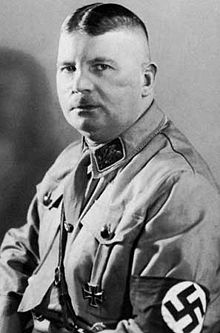
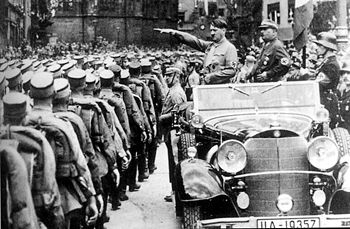
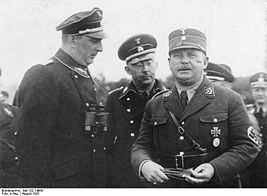
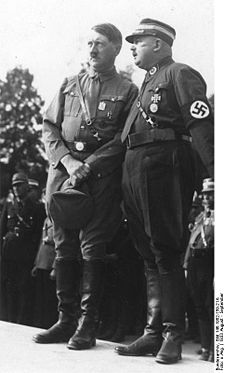
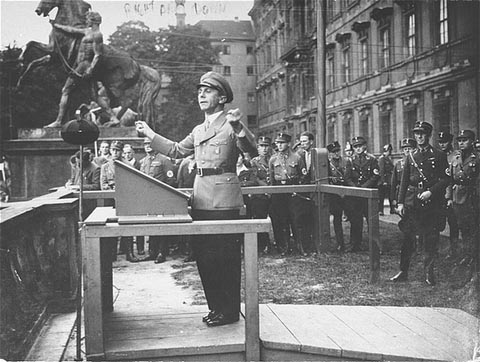
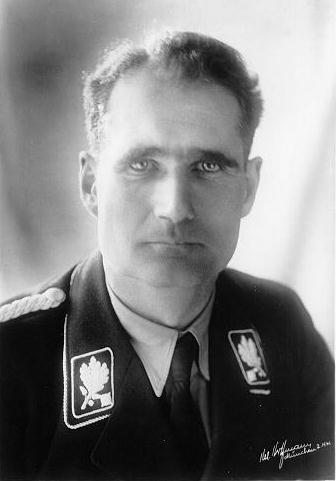
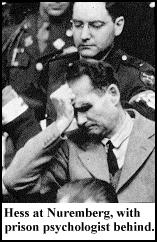
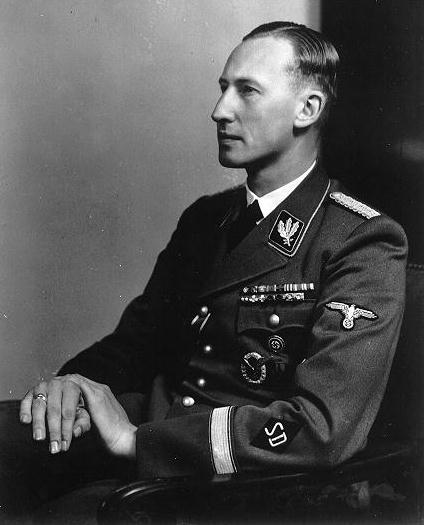
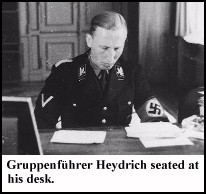 Heydrich's ruthless diligence and the rapid success of the SD earned
him a quick rise through the SS ranks - appointed SS Major by December, 1931,
then SS Colonel with sole control of the SD by July of 1932. In March of 1933,
he was promoted to SS Brigadier General, though not yet 30 years old.
Heydrich's ruthless diligence and the rapid success of the SD earned
him a quick rise through the SS ranks - appointed SS Major by December, 1931,
then SS Colonel with sole control of the SD by July of 1932. In March of 1933,
he was promoted to SS Brigadier General, though not yet 30 years old.